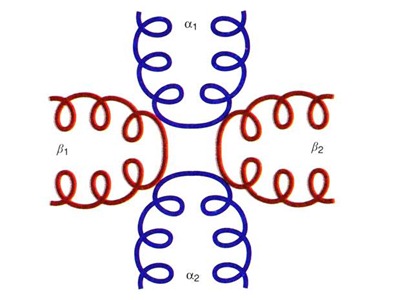In this article we will discuss about the three main biochemical pathways of major wall component formation. The biochemical pathways are: 1. Polysaccharides 2. Protein 3. Lignin.
Biochemical Pathway # 1. Polysaccharides:
They are synthesized from sugar nucleotides by polysaccharide synthases (Glycosyltransferase). The monosaccharides glucose, galactose, mannose, xylose, arabinose, glucuronic acid, galacturonic acid and fucose etc. compose the wall polysaccharides. Each of these is one of the components of sugar-nucleotide substrate.
In the sugar-nucleotide, also called nucleoside diphosphate sugar, the monosaccharide is attached through its glycosidic hydroxyl to the β-phosphate of a ribonucleoside diphosphate. In a nucleoside there occurs a ribose sugar and a nitrogen-containing base that is usually uracil or guanine (Fig. 3.12).
The formation of different sugar-nucleotides is schematically represented in the following Fig. 3.13. The names of sugar-nucleotides are alluded in abbreviated form in the text and illustration, the full name being mentioned in the caption of illustration UDP-Glc is synthesized either from Glc-1-P or from sucrose.
Other uridine containing sugar like UDP-GlcA and UDP-Gal can be formed from UDP- Glc UDP-GlcA may be the precursor of UDP-GalA and UDP-Xyl; the latter may form UDP-Ara. Glc-1-P is formed from Glc-6-P, which is derived from Fr-6-P. Fr- 6-P is normally formed in Calvin pathway and Pentose-phosphate pathway.
The guanosine-containing sugars are formed from Man-1-P, which is derived from Man-6-P. Fr-6-P gives rise to Man-6-P. Man-1-P gives rise to GDP-Man. GDP-Fuc and GDP-Glc can be formed from GDP-Man.
The different nucleoside diphosphate sugar, thus formed, transfers the monosaccharides to the growing polysaccharide chains. The membrane bound enzymes ‘sugar-nucleotide-polysaccharide glycosyltransferase’ help in the reactions. These enzymes are commonly called polysaccharide synthases or synthetases.
The reaction is as follows:
The ‘n’ and ‘n+1’ indicate the number of monosaccharides in the polypeptide chains. The monosaccharide is attached to the non-reducing end of the polysaccharide.
The polysaccharides like β (1-4) glucan (cellulose), β (1-3) glucan (callose), [β (1-3), β (1-4)] glucan, xyloglucan etc. are formed from UDP-Glc. GDP-Glc forms glucomannan. Galactan is formed from UDP-galactose.
GDP-mannose gives rise to glucomannan and galactomannan. Xyloglucan and β (1-4) xylan are formed from UDP-xylose. Arabinan is derived from UDP-Ara. UDP-GlcA, UDP-GalA and GDP-Fuc form glucuronoxylan, α (1-4) galacturonan and xyloglucan respectively.
Biochemical Pathway # 2. Proteins:
They are polypeptides where the amino acids are joined by peptide linkages between -COOH group of one amino acid and the NH2 group of another amino acid (Fig. 3.14).
 Wall polypeptides are built up of the twenty amino acids specified by the genetic code. In addition two more amino acids — hydroxyproline and isodityrosine are produced as a result of post-translational modification. The polypeptides are formed by the ribosomes of rough endoplasmic reticulum and then exported to the cell wall via Golgi apparatus.
Wall polypeptides are built up of the twenty amino acids specified by the genetic code. In addition two more amino acids — hydroxyproline and isodityrosine are produced as a result of post-translational modification. The polypeptides are formed by the ribosomes of rough endoplasmic reticulum and then exported to the cell wall via Golgi apparatus.
Wall proteins are glycoproteins, i.e. polypeptides with carbohydrate side- chains. The carbohydrates may be mono-, oligo- or polysaccharide. [Oligo- and polysaccharides are made up of monosaccharide units. There exists no sharp distinction between them. The former contains fewer in number of monosaccharides than the latter. The term polysaccharide is used when there are at least ten monosaccharide units].
The linkage between the polypeptide and the carbohydrate side-chain is often a normal glycosidic bond where one—OH group of the polypeptide is attached to the reducing terminus of carbohydrate.
The wall protein extensin is extremely rich in hydroxyproline in addition to serine, lysine, valine, tyrosine and histidine, the last one being absent from other glycoproteins. The proline residues are hydroxylated to hydroxyproline. This occurs after the completion of polypeptide chain. The enzyme prolyl hydrolase acts as catalyst in the reaction.
Ascorbate and ferrous ions are the cofactors of prolyl hydrolase. The enzyme requires α-ketogluterate as a co-substrate and uses molecular oxygen as the oxidizing agent (Fig. 3.15). The site of hydroxylation of proline residues is the endoplasmic reticulum and the Golgi apparatus.
 Diagram illustrating the hydroxylation of proline leading to the formation of hydroxyproline.
Diagram illustrating the hydroxylation of proline leading to the formation of hydroxyproline.
Uridine-diphosphate-arabinose is the donor of arabinose to hydroxyproline. Uridine-diphosphate-galactose transfers galactose to serine.
Biochemical Pathway # 3. Lignin:
The precursor of lignin is the three aromatic alcohols —coumaryl, coniferyl and sinapyl alcohol. The aromatic amino acids tyrosine and phenylalanine form the aromatic alcohols via several intermediates (Fig. 3.16).
Phenylalanine initiates the path of alcohol formation through the enzyme phenylalanine-ammonia lyase. The alcohols are oxidized within the wall by the enzyme peroxidase. As a result phenoxy radicals are produced. Lignin is formed from these radicals. The radicals can react with some polysaccharides to form linkages between lignin and wall polysaccharides.
Lignin deposition begins in the middle lamella and then spreads first to the primary wall. The deposition on secondary wall occurs after the primary wall. Lignin precursors are formed at the endoplasmic reticulum. It is then transported to the cell wall via Golgi apparatus and vesicle.




